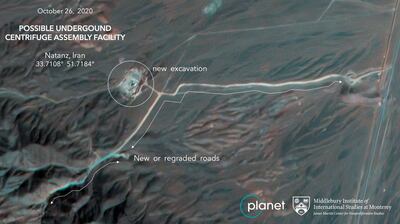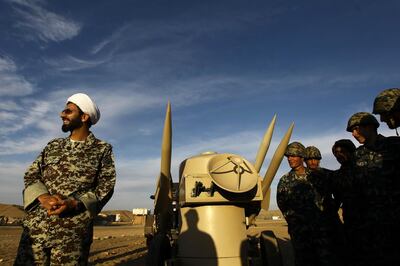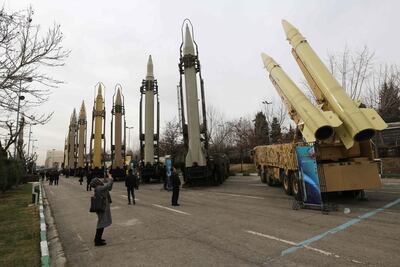New satellite imagery released on Wednesday by Planet Labs shows major construction work at Iran's Natanz nuclear site, deep in the mountains south of Tehran.
It comes a day after Rafael Grossi, the director-general of the International Atomic Energy Agency (IAEA) said that Iran was in the process of building new underground nuclear facilities.
“They have started, but it’s not completed. It’s a long process,” he told the Associated Press.
Mr Grossi would not be drawn on further details of the development, which he called “confidential information.”
According to analysts at the James Martin Centre for Nonproliferation Studies at the Middlebury Institute of International Studies, the images suggest deep excavation is ongoing at the site.

"That road also goes into the mountains so it may be the fact that they’re digging some kind of structure that’s going to be out in front and that there’s going to be a tunnel in the mountains," Jeffery Lewis, an analyst at the institute, told AP.
Last month, the head of Iran’s nuclear department Ali Akbar Salehi said that construction was part of an ongoing plan and that a facility damaged in a fire in July would be replaced with a new site, “in the heart of the mountains around Natanz.”
On July 2, an explosion destroyed several above-ground buildings at the Natanz site, which Tehran said a month later was an act of sabotage.

Since 2002, the site at Natanz, 200km south of Tehran, has been the centre of the ongoing controversy surrounding Iran’s nuclear programme, causing an 18-year disarmament crisis.
At the time, satellite imagery revealed construction work in the mountains south of the capital.
Western and regional powers are concerned about Iran’s desire to develop a nuclear weapon and officials in Washington fear that such a move could spark a regional arms race, or even a full-scale conflict.
Israel has long insisted that Iran’s continued work on a nuclear programme would be a national security red line.
On Tuesday, Congressmen Josh Gottheimer and Brian Mast announced that they were preparing legislation that would allow the transfer of bombs to the Israeli air force capable of destroying at least some of Iran's underground nuclear sites.
The devices, known as Massive Ordnance Penetrators (MOP) are so large, however, that the US would also need to transfer heavy bombers to the Israelis.
Fear that Iran and Israel have been on the path to conflict eventually convinced US officials that the 2015 Joint Comprehensive Plan of Action (JCPOA) – more commonly known as the Iran nuclear deal – was not tough enough.
President Trump subsequently pulled out of the agreement in 2018.
Increasingly tough sanctions across multiple Iranian economic sectors have been reimposed, a policy known as “maximum pressure.”
Iran has long sought to conceal and protect its nuclear activities at sites buried deep underground in order to stop their destruction from the air in a potential conflict.
Natanz and other sites are heavily defended from aerial attack.
Since 2003, Tehran has allowed IAEA inspectors to visit some of its nuclear development sites. That year, the regime informed inspectors that uranium enrichment facilities would be buried under more than 7 meters of concrete.
Iran’s efforts to protect its nuclear programme led Israel and the United States to launch one of the most elaborate sabotage operations ever mounted, using a virus called Stuxnet to disrupt and damage centrifuges used for enriching uranium.
Iran has, however, exceeded the limit of uranium it was allowed to enrich for non-military purposes under the JCPOA.

The IAEA’s most recent quarterly report noted that by August 25, Iran had stockpiled 2,105.4 kilograms of low enriched uranium, far higher than the 202.8 kilograms permitted by the JCPOA, and more than the 1,050 kilograms some experts say would be required to make a nuclear device.
But in order to get to that stage, Iran would need to enrich the uranium to 90 per cent purity, or “high enriched uranium.” That is still a long way off.
Mr Grossi remarked that while Iran continued to stockpile low enriched uranium, he believed it did not yet have enough for a nuclear weapon.
But the new revelations suggest that Iran is determined that if plans to enrich uranium to 90 per cent purity go ahead, its facilities will be safe from attack.









